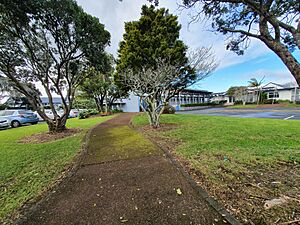Kelston, New Zealand facts for kids
Quick facts for kids
Kelston
|
|
|---|---|
|
Suburb
|
|

The Kelston Mall
|
|
| Country | New Zealand |
| Local authority | Auckland |
| Electoral ward | Whau ward |
| Local board | Whau Local Board |
| Area | |
| • Land | 180 ha (440 acre) |
| Population
(June 2023)
|
|
| • Total | 5,870 |
|
|
||
Kelston is a lively neighbourhood in West Auckland, New Zealand. It used to be a place where people made pottery and ceramics. Today, Kelston is mostly a residential area, meaning many people live here. It is also home to several schools. The area is so well-known that a special voting area, the Kelston parliamentary electorate, is named after it.
Contents
History of Kelston
Kelston has a cool history, especially along the Whau River. In the late 1800s, a company called Archibald Brothers had a big clay and pottery factory here. This factory was on the western side of the Whau River. It was an important place for making things from clay back then.
Who Lives in Kelston?
Kelston covers about 1.80 square kilometres. As of 2023, around 5870 people live here. This means there are many people living in a relatively small area.
A Growing Community
The number of people living in Kelston has been growing steadily. In 2023, there were 5,676 residents. This was an increase of 321 people since 2018. It shows that more and more families and individuals are choosing to call Kelston home.
Diverse Backgrounds
Kelston is a very diverse place, with people from many different backgrounds living together. You'll find people who identify as European (Pākehā), Māori, Pasifika, and Asian. This mix of cultures makes Kelston a vibrant and interesting community.
Many different languages are spoken in Kelston. While most people speak English, you'll also hear languages like Māori and Samoan. This shows how many different cultures are part of the community.
Schools in Kelston
Kelston is well-known for its schools, offering great learning opportunities for students of all ages.
Early Schools
One of the first schools in the area was New Lynn School. It opened in 1888 on the site where Kelston Girls' College is today. Later, in 1914, New Lynn School moved to a different spot.
In 1953, Kelston Primary School opened its doors. The next year, in 1954, Kelston High School started. It was a school for both boys and girls, located at the old New Lynn School site. It was one of the first high schools in West Auckland.
Separate High Schools
In 1963, Kelston High School split into two separate schools. Kelston Girls' High School stayed at the original site. Kelston Boys' High School moved to a new campus nearby. In 2004, Kelston Girls' High School changed its name to Kelston Girls' College.
Kelston Boys' High School
Kelston Boys' High School is a state secondary school just for boys. It teaches students from Year 9 to Year 15. The school is famous for its amazing rugby union team, the Kelston Boys High 1st XV. Many players from this school have gone on to become All Blacks, New Zealand's national rugby team. The school often wins rugby championships both in Auckland and across New Zealand.
Kelston Girls' College
Kelston Girls' College is a state secondary school just for girls. It also teaches students from Year 9 to Year 15. It provides a supportive environment for girls to learn and grow.
Kelston Deaf Education Centre
In 1958, the Kelston Deaf Education Centre opened. This special school helps children who are deaf or have hearing difficulties. It serves students from preschool all the way up to Year 15. The centre also has places for students to live. Some older students even take classes with Kelston Boys' High School. Today, it is part of Ko Taku Reo: Deaf Education New Zealand, which is the main organisation for deaf education in New Zealand.
Other Schools
- Kelston Intermediate is a school for both boys and girls in Years 7 and 8. It opened in 1958.
- Kelston Primary School and St Leonards Road School are state primary schools for students in Years 1 to 6. Both schools welcome both boys and girls.



